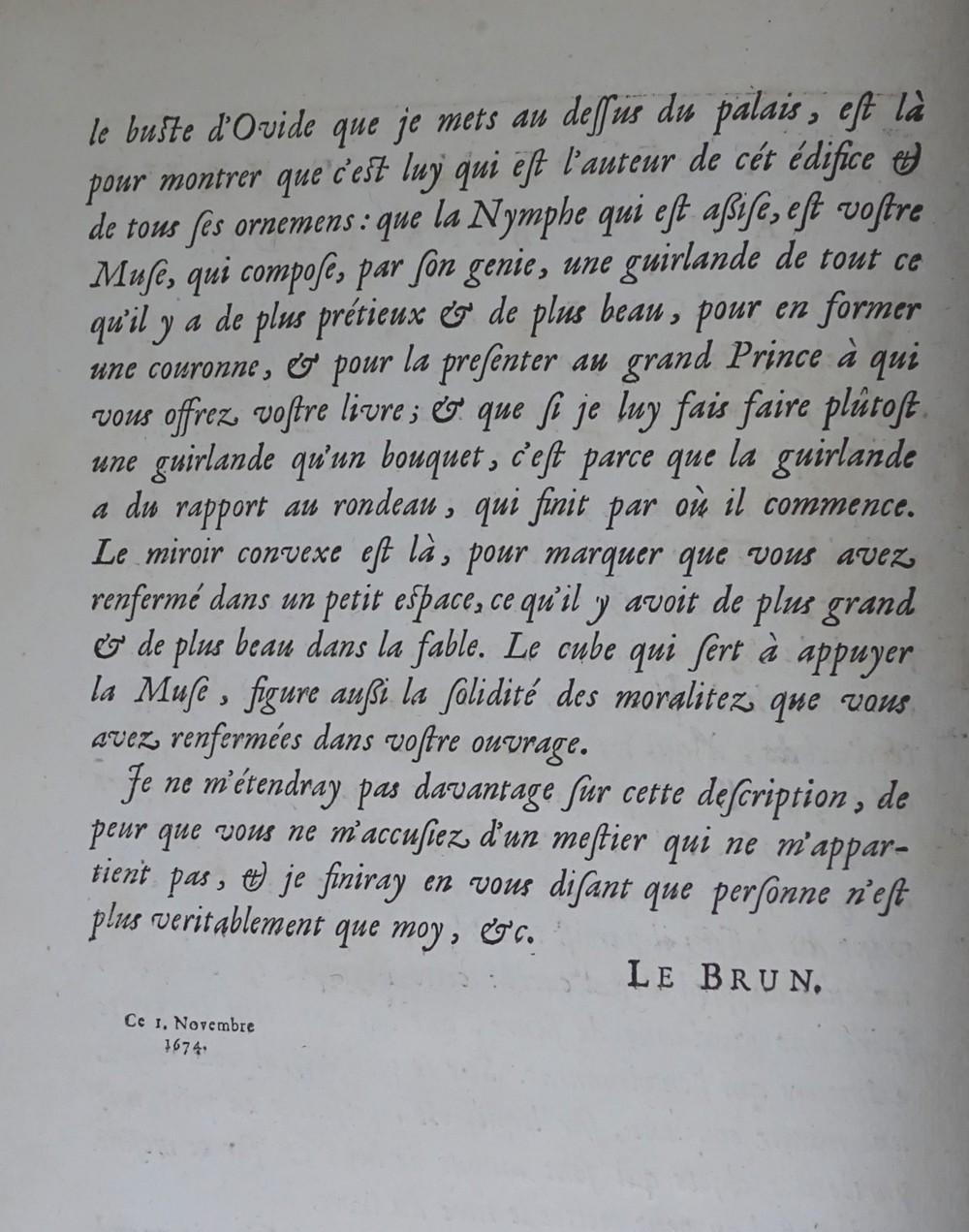|
The
fans of hand fans who give me the pleasure - and the honor - of
following me on this site or in my various articles or lectures know
that we like to "read" the stories we see (or sometimes that we think
we see!) on fans. As in other works or objects of art, they are often
linked, as we know, to ancient Greco-Roman history or to religious
history as presented in the Bible. As knowledge of these stories is
less and less a part of mainstream secondary education, it is important
that anyone wishing to open an art book, visit a museum ... or look at
a fan try to learn a little in these fields: there are in most
languages (spoken in Europe or the Americas) excellent and
easy-to-access books.
Besides understanding those historical scenes (or at the same time!),
it is necessary to know how to make an allegorical reading of paintings
or prints and therefore of the fans which are often inspired by them.
There too, one finds books allowing to understand many of these
allegories. The most famous, and the easiest to find, is the Iconologia
by Cesare Ripa (1555-1622), first published in 1593 but whith countless
later editions and translations, which has inspired European artists
for centuries..
One will easily find on the fans the most common allegorical figures,
such as Virtues, Seasons, Fame, Justice...
Let us content ourselves here with showing Virtues and Seasons on fans from the 1780s.
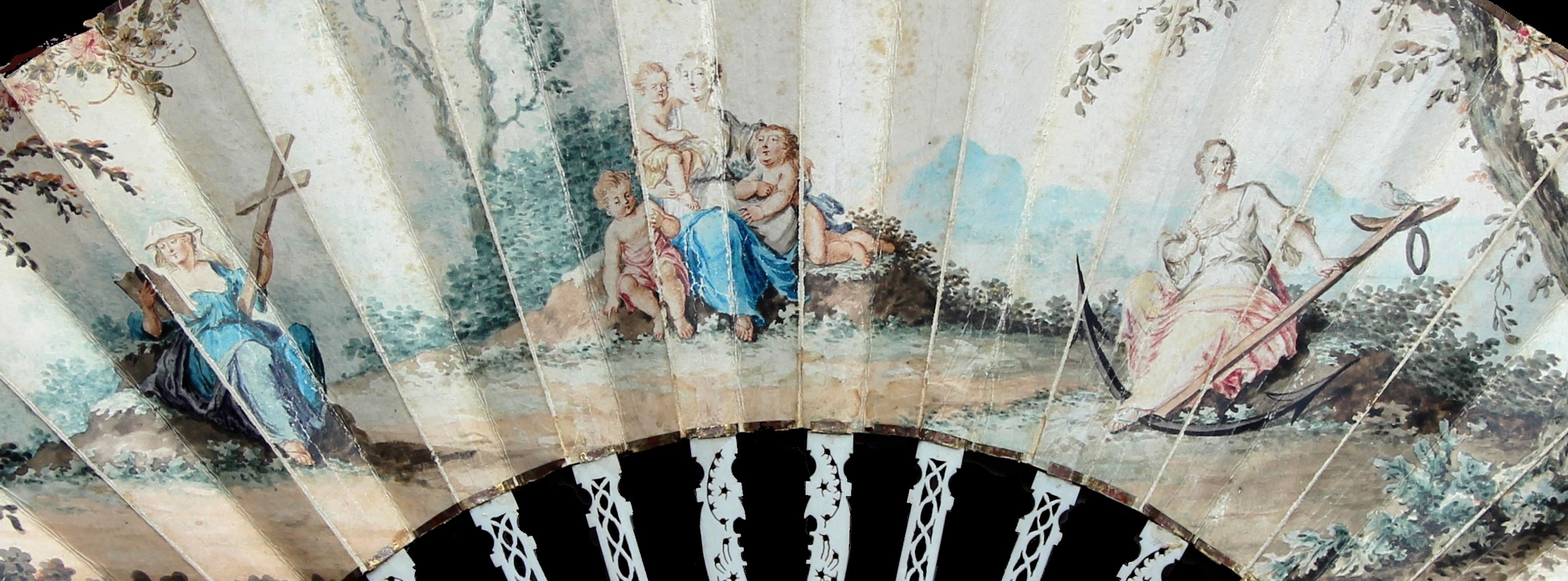
At first, Virtues: we can easily recognize on the left Faith carrying the Cross and a (sacred) book; in the center, Charity, which loves and nourishes her children, and on the right, Hope, whose anchor is the traditional attribute.
As for Seasons, simple logic
(although the ongoing climatic upheavals may contradict it!) makes easy
to see, from left to right on the fan from which we extract them, Autumn, Spring, Summer and Winter. Why this change in the natural course of time? We don't know! Note that seasons often appear in the form of their associated deities: Bacchus for Autumn, Flora or Venus for Spring, Ceres for Summer and Boreas or Vulcan for Winter.
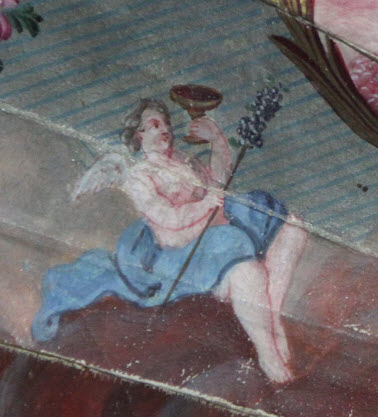 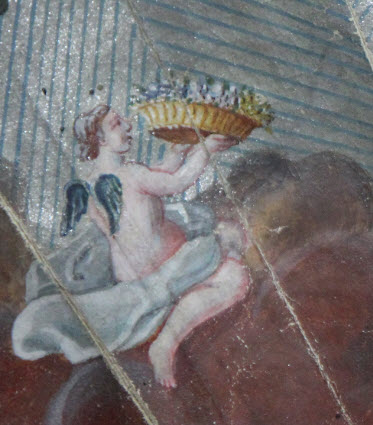 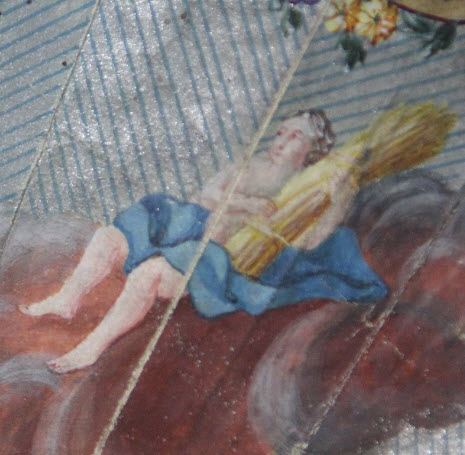 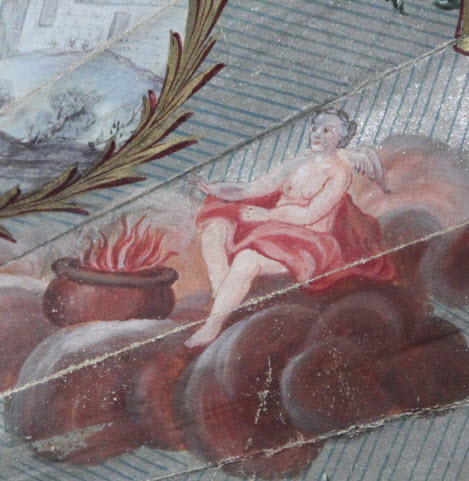
All ancient fans amateurs also
know the importance on fans of various symbols, in particular those
related to Love: doves, torches, arrows and quivers, and of course
cages and more or less flying birds, symbols of a... more or less lost virginity.

Besides
those easy to understand allegories, it is in almost all European
painting (and therefore on fans) from the 16th to the 18th century that
we must look for allegories. Of course, they sometimes end up becoming
a process that has lost the original message, before being sometimes
copied in the 19th century in a mechanical and decorative way, without
any message to convey. But it must be understood that for the 'noble'
history painters at the time of Louis XIV there was hardly a painting
that could not compose a real discourse. This discourse was sometimes
composed by the commissioner: so many religious paintings, made for a
church, a community, a specific brotherhood, and integrated into an
overall decoration (unfortunately often disappeared due to fires,
looting, refusal of images by Protestantism, vandalism of the French
Revolution ... and sometimes even overzealous post-Vatican II Concile
Catholic priests!). So the indications of the sponsors or the
explanations of the artists have often disappeared. They had perhaps
been essentially verbal, though.
It therefore seems interesting to give here an illustration entirely
commented on by its author, the great painter Charles Le Brun, first
painter to King Louis XIV. The latter had asked Isaac de Bensérade
(1612-1691), one of his favorite poets, co-author of many of the ballets so appreciated by the king, to transcribe into poems, for the instruction of the Dauphin, Ovid's Metamorphoses.
This sumptuous work, illustrated by François Chauveau (one of the best
engravers of the time) assisted by Sébastien Le Clerc and Jean
Lepautre, was published in 1676. Despite the extreme quality of the
engravings -still quite useful for the old fans amateur wanting
to identify a mythological scene!- and of the printing of the texts, it
was not a success: the type of poems chosen was no longer in fashion.
They are 13-line cross-rhyming poems, to which a verse of half of the
first line is added in the middle and at the end. In my opinion, the
work of Bensérade would have deserved a better reception, because it
sums up very well a number of fables, and not without wit. But we do
not study here these poems, nor the remarkable engravings which
illustrate them, although they are full of allegories, as you may guess.
What we are looking at now is the frontispiece of the book, which we show below.

Generally, on seeing this type of illustration we must try to guess the intentions of the artist. But what was (perhaps!) understandable to the educated public in 1676 is generally no longer so. Here, we are fortunate that Charles Le Brun explained in detail his design (and therefore his drawing, the same word 'dessein' in XVIIth century French-) in a letter to Isaac de Bensérade, which this one inserted at the head of the book. Here is this letter:
To
make it easier for you to read both the text and the allegory, I
reproduce it below with Charles Le Brun's text in English. Translation
and subsequent mistakes are mine!
 |
M. Le Brun's letter to M. de Benserade
Find
here, Sir, a slight idea of the frontispiece of your book that I am
sending you to get your opinion before finishing this drawing.
I represent in the middle of the sheet and in the distance a magnificent palace, on top of which I paint Ovid's bust. The entire facade of this palace is enriched with paintings, bas-reliefs and statues, which represent several subjects of the Metamorphoses. In
front of this palace, there is a parterre filled with plants and
flowers, and surrounded by a number of trees to which the heroes of the
Fable have given life. Around
these plants and these trees are several Cherubs or Genies, who pick
the flowers and the gums of these same plants and these same trees. On
the front of the drawing we see a nymph sitting and leaning on a cube
or square pedestal: this Nymph is busy making a garland of flowers,
brought to her by the little cherubs who surround her. On this pedestal you see a convex mirror on which is represented in small a part of the objects which are around it. On this same pedestal we can put the title of the book.
I do not believe, Sir, that this drawing is in great need of explanation. Because
I think you understand that the bust of Ovid that I put above the
palace is there to show that he is the author of this building and all
its ornaments;
that
the sitting Nymph is your Muse, who composes by her genius a
garland of all that is most beautiful and precious, to form a crown and
to present it to the great prince to whom you offer your book; and that if I make her composing a garland rather than a bouquet, it's because the garland has a relation to the rondeau, which ends with where it begins.
The convex mirror is there to show that you have enclosed in a small space what was greatest and most beautiful in the fable.
The cube which serves to support the muse also represents the solidity of the moralities which you have contained in your work.
I
will not continue this description any further, lest you accuse me of a
job that does not belong to me, and I will end by telling you that no
one is more truly yours than me etc.
Le Brun
Ce 1er novembre 1674.
|
We will easily find on our fans characters very similar to those represented by Charles Le Brun on illustrating these Metamorphoses d'Ovide en Rondeaux by Bensérade. Should they be given exactly the same meaning? Probably not! But everyone will enjoy, I'm sure, looking for the meaning of the images on their fan leaves, and "reading them"!
|






